
St. George's Cathedral, Chennai
Encyclopedia

Church of South India
The Church of South India is the successor of the Church of England in India. It came into being in 1947 as a union of Anglican and Protestant churches in South India. With a membership of over 3.8 million, it is India's second largest Christian church after the Roman Catholic Church in India...
, (previously Anglican), cathedral in Chennai
Chennai
Chennai , formerly known as Madras or Madarasapatinam , is the capital city of the Indian state of Tamil Nadu, located on the Coromandel Coast off the Bay of Bengal. Chennai is the fourth most populous metropolitan area and the sixth most populous city in India...
, India
India
India , officially the Republic of India , is a country in South Asia. It is the seventh-largest country by geographical area, the second-most populous country with over 1.2 billion people, and the most populous democracy in the world...
. The cathedral was built in 1815 AD. St. George’s occupies an important place in the history of Christianity in India, as the Church of South India
Church of South India
The Church of South India is the successor of the Church of England in India. It came into being in 1947 as a union of Anglican and Protestant churches in South India. With a membership of over 3.8 million, it is India's second largest Christian church after the Roman Catholic Church in India...
was inaugurated here on September 27, 1947. The Cathedral was packed to capacity and the big pandal
Pandal
A pandal is fabricated structure, either temporary or permanent, in a religious ceremonies including weddings.It is derived from Tamil...
outside held over 2000 people. It marked the breaking down of ecclesiastical barriers between Protestants of various traditions.
The architecture of St. George’s Cathedral is remarkable for its tall spire
Spire
A spire is a tapering conical or pyramidal structure on the top of a building, particularly a church tower. Etymologically, the word is derived from the Old English word spir, meaning a sprout, shoot, or stalk of grass....
, pillars, marble statues, mural tablets and memorials inside. The Cathedral is a piece of architectural grandeur resting on a tier of steps. The Governors of Fort St. George and their families worshipped here as also the Viceroys when they visited Madras.
History
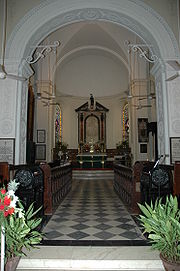
Anno Domini
and Before Christ are designations used to label or number years used with the Julian and Gregorian calendars....
. It is stated that the church was completed by the people themselves with the aid of a lottery fund.
It cost 41,709 pagoda
Pagoda
A pagoda is the general term in the English language for a tiered tower with multiple eaves common in Nepal, India, China, Japan, Korea, Vietnam and other parts of Asia. Some pagodas are used as Taoist houses of worship. Most pagodas were built to have a religious function, most commonly Buddhist,...
s and with the furniture, the organ
Pipe organ
The pipe organ is a musical instrument that produces sound by driving pressurized air through pipes selected via a keyboard. Because each organ pipe produces a single pitch, the pipes are provided in sets called ranks, each of which has a common timbre and volume throughout the keyboard compass...
and the architect’s commission increasing the cost to 57,225 pagodas. 1 Pagoda was equivalent to Indian Rupees 3.50.
The British East India Company
British East India Company
The East India Company was an early English joint-stock company that was formed initially for pursuing trade with the East Indies, but that ended up trading mainly with the Indian subcontinent and China...
's Senior Engineer Col. J. L. Caldwell designed the church, and his assistant Captain De Havilland finished the construction. The site with an advantageous location was called the Choultry Plain. Though the Presidency Chaplain conducted the services from 1815, it was on 6 January 1816, that the first Anglican Bishop of Calcutta
Bishop of Calcutta
The Bishop of Calcutta exercises episcopal leadership over the Diocese of Calcutta of the Church of North India. The diocese was established in 1813 as part of the Church of England and the first bishop was Thomas Fanshawe Middleton and the second Reginald Heber...
, Rt. Rev. Thomas Fanshaw Middleton consecrated the church to “the service of God according to the use of the Church of England
Church of England
The Church of England is the officially established Christian church in England and the Mother Church of the worldwide Anglican Communion. The church considers itself within the tradition of Western Christianity and dates its formal establishment principally to the mission to England by St...
”.
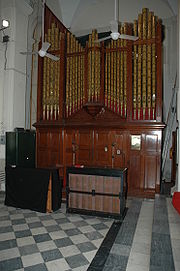
Congregation
Since 1815, the church has grown significantly in various ways. The south–eastern corner was set aside for the cemeteryCemetery
A cemetery is a place in which dead bodies and cremated remains are buried. The term "cemetery" implies that the land is specifically designated as a burying ground. Cemeteries in the Western world are where the final ceremonies of death are observed...
. De Havilland's wife's funeral was the first to be held here. The guard rail of the graveyard was made up of war insignia
Insignia
Insignia or insigne pl -nia or -nias : a symbol or token of personal power, status or office, or of an official body of government or jurisdiction...
including musket
Musket
A musket is a muzzle-loaded, smooth bore long gun, fired from the shoulder. Muskets were designed for use by infantry. A soldier armed with a musket had the designation musketman or musketeer....
s and bayonet
Bayonet
A bayonet is a knife, dagger, sword, or spike-shaped weapon designed to fit in, on, over or underneath the muzzle of a rifle, musket or similar weapon, effectively turning the gun into a spear...
s captured by British forces at the Battle of Seringapatam
Battle of Seringapatam
The Siege of Seringapatam was the final confrontation of the Fourth Anglo-Mysore War between the British East India Company and the Kingdom of Mysore. The British achieved a decisive victory after breaching the walls of the fortress at Seringapatam and storming the citadel. Tippu Sultan, Mysore's...
in 1799. The Directors of the British East India Company presented the turret clock
Turret clock
A Turret clock is a clock mounted in a tower or turret, usually to show the current time on a dial with hand or to announce the time by strike, or both. It can also have more than one dial to show days, moon phases, and other astronomical data.-Sundials:...
to the Trustees in 1828. The turret clock was set up on the three faces of the Church steeple, which is 139 feet (42 m) high. The belfry
Bell tower
A bell tower is a tower which contains one or more bells, or which is designed to hold bells, even if it has none. In the European tradition, such a tower most commonly serves as part of a church and contains church bells. When attached to a city hall or other civic building, especially in...
was completed in 1832. The altar
Altar
An altar is any structure upon which offerings such as sacrifices are made for religious purposes. Altars are usually found at shrines, and they can be located in temples, churches and other places of worship...
table was donated by Miss De La Fond. The bells and the chiming device were donated by Mr. Banbury and the Rev. Thomas Foulkes respectively. The brass altar cross was donated by Surgeon-General Cornish
William Robert Cornish
William Robert Cornish was a British physician who served in India for more than thirty years, and became the Surgeon-General—head of medical services—in the Madras Presidency...
. The lectern
Lectern
A lectern is a reading desk with a slanted top, usually placed on a stand or affixed to some other form of support, on which documents or books are placed as support for reading aloud, as in a scripture reading, lecture, or sermon...
was a memorial tribute by his friends to Archdeacon
Archdeacon
An archdeacon is a senior clergy position in Anglicanism, Syrian Malabar Nasrani, Chaldean Catholic, and some other Christian denominations, above that of most clergy and below a bishop. In the High Middle Ages it was the most senior diocesan position below a bishop in the Roman Catholic Church...
Warlow. The Episcopal chair was a gift from F. E. Kneale. The Litany stool
Prie-dieu
A prie-dieu is a type of prayer desk primarily intended for private devotional use, but also often found in churches of the European continent. It is a small ornamental wooden desk furnished with a sloping shelf for books, and a cushioned pad on which to kneel. Sometimes, instead of the sloping...
and the clergy seats were carved by W. S. Whiteside of the Madras Civil Service. The gold chalice
Chalice (cup)
A chalice is a goblet or footed cup intended to hold a drink. In general religious terms, it is intended for drinking during a ceremony.-Christian:...
and paten
Paten
A paten, or diskos, is a small plate, usually made of silver or gold, used to hold Eucharistic bread which is to be consecrated. It is generally used during the service itself, while the reserved hosts are stored in the Tabernacle in a ciborium....
for Holy Communion were donated by Lt. Col. Herbert St. Clare Carruthers in 1908. They weigh 3 lb 7 ounces (1.6 kg) in 18 carat (75%) gold. The chalice is set with diamonds in the form of a cross. The altar rail was erected by P. Orr and Sons to the memory of Edward William Orr, a member of the choir
Choir
A choir, chorale or chorus is a musical ensemble of singers. Choral music, in turn, is the music written specifically for such an ensemble to perform.A body of singers who perform together as a group is called a choir or chorus...
, who died in 1913. The marble baptismal font
Baptismal font
A baptismal font is an article of church furniture or a fixture used for the baptism of children and adults.-Aspersion and affusion fonts:...
was gifted by the congregation.
Cathedral
The St. George’s Church became prominent as the cathedral of Madras in 1835. The Altar of the Cathedral is majestic. The reredosReredos
thumb|300px|right|An altar and reredos from [[St. Josaphat's Roman Catholic Church|St. Josaphat Catholic Church]] in [[Detroit]], [[Michigan]]. This would be called a [[retable]] in many other languages and countries....
is a depiction of the ascension of Lord Jesus Christ sculpted in alabaster
Alabaster
Alabaster is a name applied to varieties of two distinct minerals, when used as a material: gypsum and calcite . The former is the alabaster of the present day; generally, the latter is the alabaster of the ancients...
, at the top of which stands a black marble statue of St George, the patron Saint of England, after whom the church has been named. The chancel
Chancel
In church architecture, the chancel is the space around the altar in the sanctuary at the liturgical east end of a traditional Christian church building...
was later lengthened with a ten foot radius semicircular apse
Apse
In architecture, the apse is a semicircular recess covered with a hemispherical vault or semi-dome...
. The Vestry
Vestry
A vestry is a room in or attached to a church or synagogue in which the vestments, vessels, records, etc., are kept , and in which the clergy and choir robe or don their vestments for divine service....
and the Lady chapel
Lady chapel
A Lady chapel, also called Mary chapel or Marian chapel, is a traditional English term for a chapel inside a cathedral, basilica, or large church dedicated to the Blessed Virgin Mary...
were also added later. In 1884, the Trustees replaced the plaster roof of the nave by one of teak
Teak
Teak is the common name for the tropical hardwood tree species Tectona grandis and its wood products. Tectona grandis is native to south and southeast Asia, mainly India, Indonesia, Malaysia, and Burma, but is naturalized and cultivated in many countries, including those in Africa and the...
and patterned it with papier-mâché.
Stained glass windows
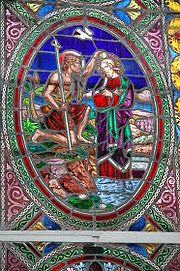
Stained glass
The term stained glass can refer to coloured glass as a material or to works produced from it. Throughout its thousand-year history, the term has been applied almost exclusively to the windows of churches and other significant buildings...
windows of St. George's Cathedral are a marvel by itself. On either side of the altar in vibrant colours are two panels describing two important events in the life of Jesus. The left panel is a vivid depiction of the Baptism of Jesus
Baptism of Jesus
The baptism of Jesus marks the beginning of Jesus Christ's public ministry. This event is recorded in the Canonical Gospels of Matthew, Mark and Luke. In John 1:29-33 rather than a direct narrative, the Baptist bears witness to the episode...
by John the Baptist
John the Baptist
John the Baptist was an itinerant preacher and a major religious figure mentioned in the Canonical gospels. He is described in the Gospel of Luke as a relative of Jesus, who led a movement of baptism at the Jordan River...
in the River Jordan. One can see the Holy Spirit descending in the form of a dove. The right panel depicts the resurrected Lord with Mary Magdalene
Mary Magdalene
Mary Magdalene was one of Jesus' most celebrated disciples, and the most important woman disciple in the movement of Jesus. Jesus cleansed her of "seven demons", conventionally interpreted as referring to complex illnesses...
. There are stained glass panels on top of all the doors of the Cathedral. Sunlight filters through these shining examples of medieval art, leaving the entire Cathedral bathed in rich, warm hues.
Memorials, tablets and statues
At the left entrance to the Cathedral is the statue of the Rt. Rev. Daniel CorrieDaniel Corrie
The Rt Rev Daniel Corrie was an English churchman, the inaugural Bishop of Madras.He was educated at St Catharine's College, Cambridge. He became archdeacon of Calcutta in 1823. He was consecrated bishop in 1835 and died on 5 February 1837. The Times later reported that he had been taken ill at...
, the first Bishop of Madras
Bishop of Madras
The Bishop of Madras was the Ordinary of the Anglican Church in Madras from its inception in 1835 until the foundation of the Church in India, Pakistan, Burma and Ceylon in 1927; and since then head of one of its most prominent Dioceses.-External links:*...
(1835–1837). Associated with many schools, he is shown with an open Bible blessing an Indian boy in loin cloth, a sacred thread and a tuft. At the main entrance is the Rt. Rev. Thomas Dealtry
Thomas Dealtry
The Rt Rev Thomas Dealtry was an Anglican Bishop in the 19th century.Mainly self-taught, Dealtry worked as an usher in a Doncaster school and then as tutor to a private family, where he eloped with the sister of his pupil in 1819. After she died, he married again in 1824. He then studied at St...
, Bishop of Madras (1849–1861) in bas-relief. One who ordained 151 clergymen is seen blessing two young priests attended by his son Archdeacon Dealtry, the Rev. Lugard and Rev. Murphy. At the entrance of the Lady chapel is the bust of the Rt. Rev. Frederick Gell
Frederick Gell
The Rt Rev Frederick Gell was an eminent Anglican clergyman in the second half of the 19th century.Frederick Gell was born in 1820 and educated at Trinity College, Cambridge. In 1843 he was appointed a Fellow at Christ's College, Cambridge, and later that year ordained...
, Bishop of Madras (1861–1899). Nearby is the alto-relieve statue of Reginald Heber
Reginald Heber
Reginald Heber was the Church of England's Bishop of Calcutta who is now remembered chiefly as a hymn-writer.-Life:Heber was born at Malpas in Cheshire...
by Chantry.
There is a memorial tablet for the first Indian Bishop of Madras, the Rt. Rev. David Chellappa (1955–1964) erected by the congregation of St. George's Cathedral. The consecration and installation of Bishop David Chellappa as the first Indian Bishop in Madras in 1955 was an important occasion in the Cathedral. Two other memorials for Indians are that of Dewan Bahadur N. Subrahmanyam (1841–1911)—Administrator General of Madras who founded and endowed the Kalyani Hospital and Dr. R. D. Paul who died in 1975 “after a long and devoted service to the Church, the State and the Community”.
Many memorials were erected to the memory of British soldiers, religious leaders, educationists, police officers, engineers, businessmen, judges, medical officers and their families. There is a tablet for the Rt. Rev. Robert Caldwell
Robert Caldwell
Bishop Robert Caldwell was an Evangelist missionary and linguist, who academically established the Dravidian family of languages. He served as Assistant Bishop of Tirunelveli from 1877. He was described in The Hindu as a 'pioneering champion of the downtrodden' and an 'avant-garde social reformer'...
, who for 53 years devoted himself to the furtherance of the Gospel among the Tamil people of Tirunelveli. Well known as a scholar and philologist, he served also as assistant to the Bishop of Madras and died at Kodaikanal
Kodaikanal
-Climate:Kodaikanal has a monsoon-influenced subtropical highland climate . The temperatures are cool throughout the year due to the high elevation of the city.-Economy:...
in 1891. From another tablet, we see that Frederick Rowlandson was Registrar of the Diocese of Madras for 53 years and died in 1929. Similarly we see from a plaque that Edward Sell
Edward Sell (canon)
Canon Edward Sell was an Anglican orientalist, writer and missionary in India.- Biography :Sell was born on 24 January 1839 in Wantage in Berkshire. He was educated at the Church Missionary College in Islington, London, completing his studies in 1862...
, Canon of St. George’s Cathedral had worked for 67 years in Madras and died in 1932 at the age of 93. John Mousley, the first Archdeacon in Madras (1815–1819) has a commemoration tablet by Flaxman.
Some important members
Some important people have worshipped in the Cathedral as is revealed by the memorial tablets. There is a statue in memory of James Stephen Lushington, Bengal Civil Service, and son of S. R. Lushington — Governor of Madras, who died young in 1832. In the Lady Chapel there is a plaque in memory of Amelia, 21, who died in 1833, the only child of Sir Frederick AdamFrederick Adam
General Sir Frederick Adam GCB GCMG was a Scottish major-general at the Battle of Waterloo, in command of the 3rd Brigade. He was the fourth son of William Adam of Blair Adam and his wife Eleanora, the daughter of Charles Elphinstone, 10th Lord Elphinstone.-Military career:At the age of fourteen...
, Governor of Madras. Other memorials exist for William Montague Douglas Home, second son of the Earl of Home
Earl of Home
The title Earl of Home was created in 1605 in the Peerage of Scotland for Alexander Home of that Ilk, who was already the 6th Lord Home.The Earl of Home holds the subsidiary titles of Lord Home , and Lord Dunglass , in the Peerage of Scotland; and Baron Douglas, of Douglas in the County of Lanark ...
, who died in 1822, Sir Joseph Henry Stone (1858–1941) Director of Public Instruction, Hitchcock
Hitchcock
Hitchcock may refer to people with the surname Hitchcock:* Alfred Hitchcock , film director* A. S. Hitchcock , American botanist and agrostologist* Billy Hitchcock , American baseball player...
of the Indian Police (1884–1926), Sir John Norton — Puisne Justice
Puisne Justice
A Puisne Justice or Puisne Judge is the title for a regular member of a Court. This is distinguished from the head of the Court who is known as the Chief Justice or Chief Judge. The term is used almost exclusively in common law jurisdictions such as England, Australia, Kenya, Canada, Sri Lanka,...
who was buried at sea on 20 September 1843, Thomas Moore Lane
Thomas Moore-Lane
Thomas Moore-Lane was born in Co. Wexford, Ireland and was son of Thomas Moore-Lane of Lansboro, and Emily Gordon. His surname has also been recorded as Moore Lane.- Career :...
— Physician to the Nawab and Private Secretary to the Governor who died in 1844 and Thomas Parry who died at Porto Novo in 1824 after “a residence of 37 years at Madras with unblemished reputation”.
There is an interesting memorial of a woman feeding a snake in tribute to Dr. John Mack, Surgeon to the Governor’s Bodyguard and Physician to the Nawab of Carnatic who died in 1852.
Military personnel
Many military personnel were prominent in their affiliation to St. George’s Cathedral. Tablets have been raised in memory of Major George Broadfoot of the 34th Madras Infantry who fought in the First Anglo-Afghan WarFirst Anglo-Afghan War
The First Anglo-Afghan War was fought between British India and Afghanistan from 1839 to 1842. It was one of the first major conflicts during the Great Game, the 19th century competition for power and influence in Central Asia between the United Kingdom and Russia, and also marked one of the worst...
and fell at the Battle of Ferozeshah
Battle of Ferozeshah
The Battle of Ferozeshah was fought on 21 December and 22 December 1845 between the British and the Sikhs, at the village of Ferozeshah in Punjab. The British were led by Sir Hugh Gough and Governor-General Sir Henry Hardinge, while the Sikhs were led by Lal Singh.The British emerged victorious,...
in 1845, Major General Sir Robert Henry Dick
Robert Henry Dick
Sir Robert Henry Dick KCB KCH, KOV was a Scottish soldier, son of a doctor in the East India Company's service.- Military Career :He entered the British Army in 1800.He was lieutenant in the 42nd Regiment of Foot in 1804....
— a hero of the Peninsular War
Peninsular War
The Peninsular War was a war between France and the allied powers of Spain, the United Kingdom, and Portugal for control of the Iberian Peninsula during the Napoleonic Wars. The war began when French and Spanish armies crossed Spain and invaded Portugal in 1807. Then, in 1808, France turned on its...
, Major John Frederick Graham who fell at the Battle of the Somme in 1916, Col. John Impett who served at Waterloo
Battle of Waterloo
The Battle of Waterloo was fought on Sunday 18 June 1815 near Waterloo in present-day Belgium, then part of the United Kingdom of the Netherlands...
at the age of 15 and died as Sheriff of Madras in 1866, Lt. Col. James Drever who died “from the effects of a coup de soleil
Hyperthermia
Hyperthermia is an elevated body temperature due to failed thermoregulation. Hyperthermia occurs when the body produces or absorbs more heat than it can dissipate...
in China” in 1842 and Lt. James Forsyth who died of cholera while on expedition to China in the same year.
Cathedral bells
The Cathedral has eight bells that were manufactured by Messrs Mears & Steinbank, Founders, London in the year 1871. They were presented to St. George’s Cathedral by Mr. G. Banbury during Christmas 1873. The chiming device was donated by Rev. Thomas Foulkes. All the eight bells vary in size. The height of the largest bell is 42”, its diameter is 48” and its circumference 150” approximately. The smallest bell is 24” in height, 30” in diameter and approximately 94” in circumference. These bells were installed inside the central portion of the pinnacle below the clock and about 50’ above the ground level. They are fixed on wooden beams about one foot in thickness on all sides — four bells at the bottom and four on the top.Cathedral organisation
St. George’s Cathedral has a well knit structural organisation for management. The Trustees include senior members of the Cathedral appointed by the Bishop of Madras. The trustees look after the assets of the Cathedral. The Pastorate Committee consists of 10 elected members including the Secretary, Treasurer and Assistant Secretary. Women and youth are represented. Other important church members are the Lay Leaders, Choir with leader and organist, Music Director of the Men’s Chorus, Superintendent of Sunday School, Superintendent of the Home for Senior Citizens, the Cathedral Manager and Sexton.The cathedral management works under the leadership of the Presbyter and Associate Presbyter. It is an elective, democratic system and everyone has her part to play.
Progress since 1947
Since 1947, the Cathedral has acquired a new setting and atmosphere. The Trustees and the congregation have demonstrated their loyalty in various ways. Several building projects including a new parsonage, the Vergers quarters and the Parish Hall have been achieved. Today St. George’s Cathedral with a church membership of over 1200 families continues its role as the Mother Church and as the Church of the City. The Community Welfare Centre, Leprosy Project, Sunday School, Youth, Women’s, Men’s and Teen Fellowships, Green Pastures, Prayer Groups, Gospel Teams, Quiz Programs, Bible Study Groups and the Home for the Aged have progressed well. The Community Welfare Centre has a Sewing School, a Typewriting Institute, a Day Care Centre, a Medical Clinic, and other extension projects. The pipe organ has been repaired and the cemetery cleaned up.Cathedral layout
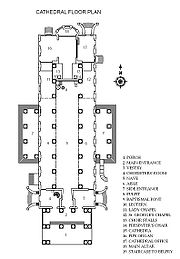
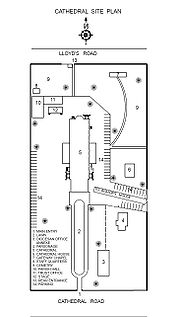
Bishops of the Diocese of Madras
- Rt. Rev. Daniel Corrie 1835-1837
- Rt. Rev. George John Trevor Spencer 1837-1849
- Rt. Rev. Thomas Dealtry 1849-1861
- Rt. Rev. Frederick Gell 1861-1899
- Rt. Rev. Henry Whitehead 1899-1922
- Rt. Rev. Edward Harry Mansfield Waller 1923-1941
- Rt. Rev. Arthur Michael Hollis 1942-1954
- Rt. Rev. Dr. David Chellappa 1955-1964
- Rt. Rev. Lesslie NewbiginLesslie NewbiginBishop James Edward Lesslie Newbigin was a Church of Scotland missionary serving in the former Madras State , India, who became a Christian theologian and bishop involved in missiology, ecumenism, and the Gospel and Our Culture Movement.-Biography:Born in Newcastle upon Tyne, Newbigin's schooling...
1965-1974 - Rt. Rev. Dr. Sundar Clarke 1974-1989
- Rt. Rev. Dr. Masillamani Azariah 1990-1999
- Rt. Rev. Dr. V. Devasahayam 1999-
Presbyters of St. George’s Cathedral
- Rev. Clarence Edwin Brett 1947
- Rev. John Murdoch Wallace 1947-1948
- Rev. Robert Leslie Watson 1948-1958
- Rev. E.J.M. Wyld & Rev. R.L. Manson 1957-1958
- Rev. Ian Matheson Calvert 1959-1962
- Rev. David Max Samuel 1962-1964
- Rev. Sundar Clarke 1964-1969
- Rev. Eugene Paul Heideman 1969-1970
- Rev. Ebenezer Immanuel 1970-1975
- Rev. Swamiappan David 1975-1980
- Rev. Christopher Solomon 1980-1984
- Rev. R. Trinity Baskeran 1984-1985
- Rev. D. Amos Manoharan 1985-1990
- Rev. David Devairakkam 1990-1995
- Rev. Oliver T. Arockiam 1995-1999
- Rev. N.G. Mathew 1999-2003
- Rev. Dr. Noel Jason 2003-2006
- Rev. D.C. Premraj 2006-

